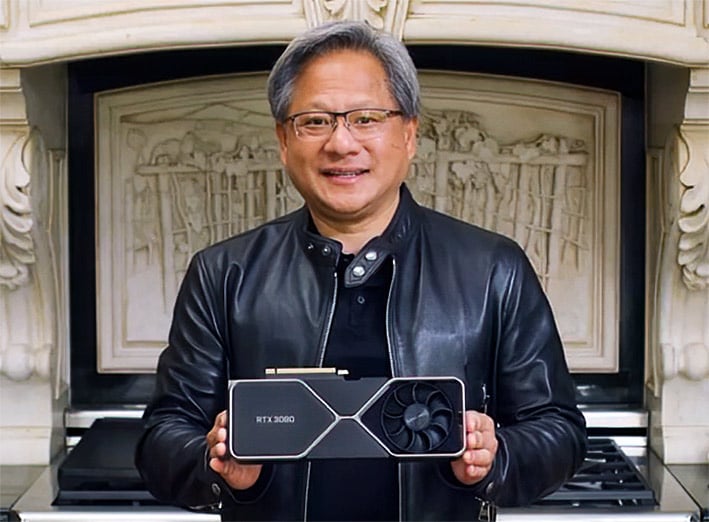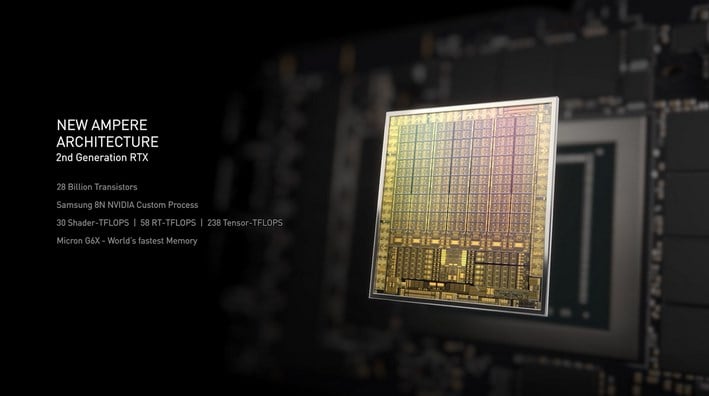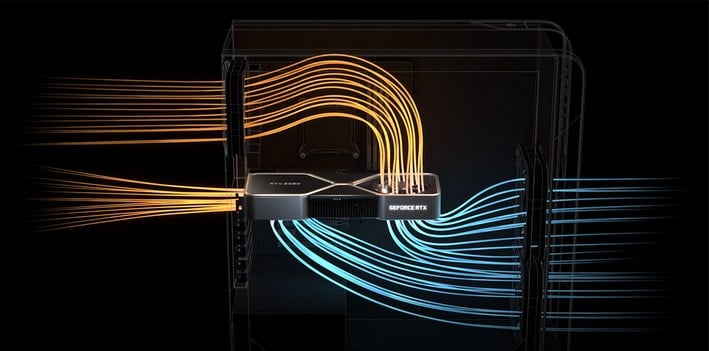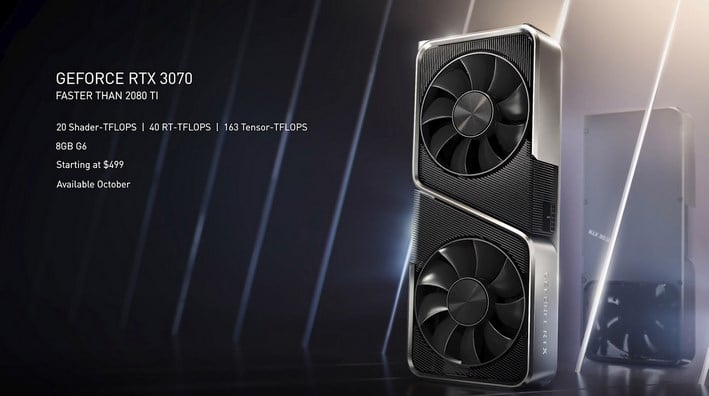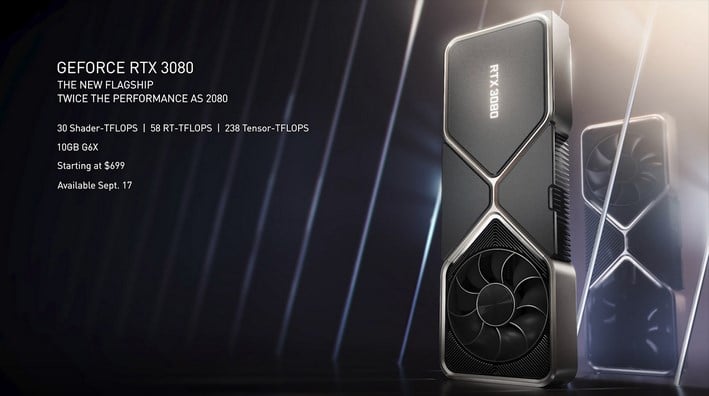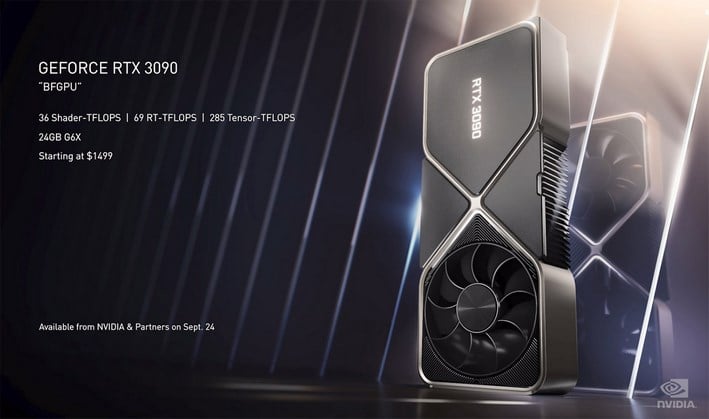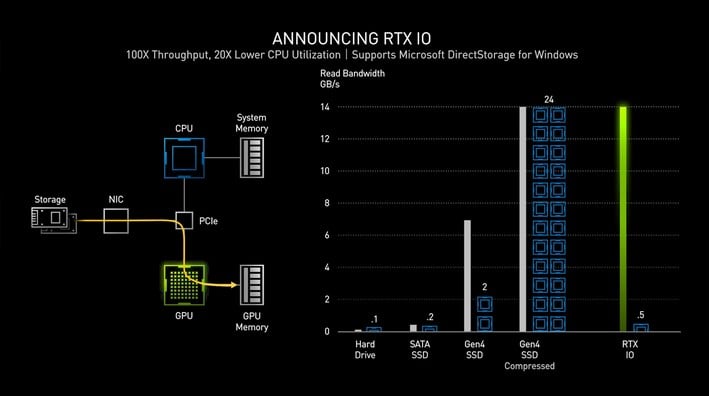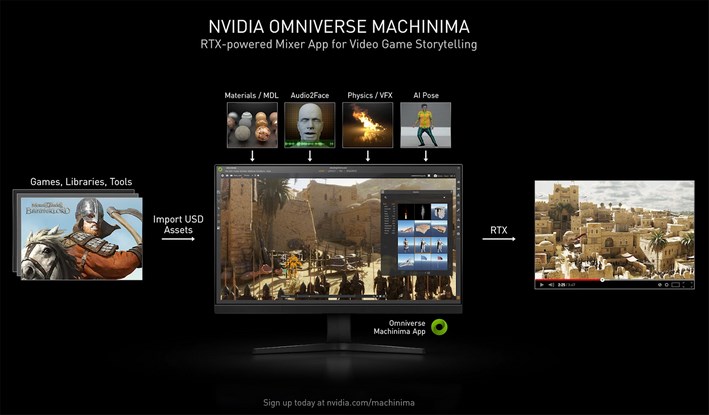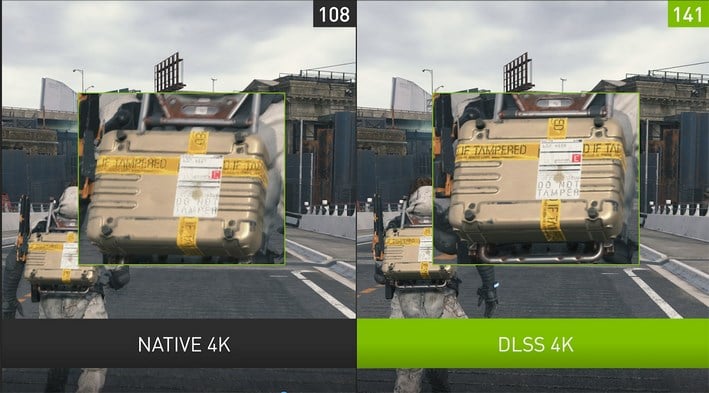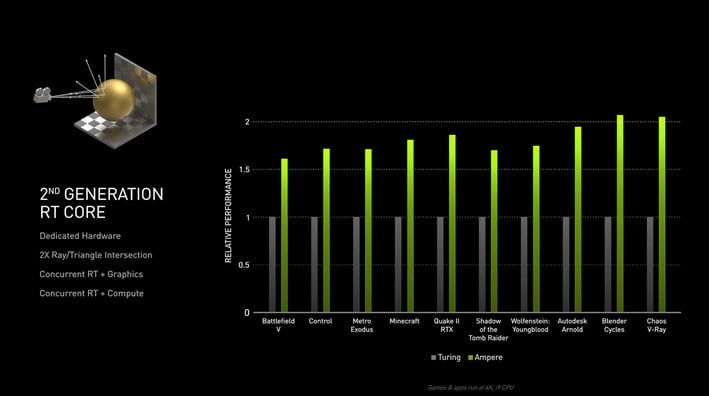NVIDIA Ampere GeForce RTX 3090, RTX 3080 And 3070 Debut With Killer Gaming Performance
NVIDIA's Ampere-Based GeForce RTX 3070, 3080, And 3090 Unveiled
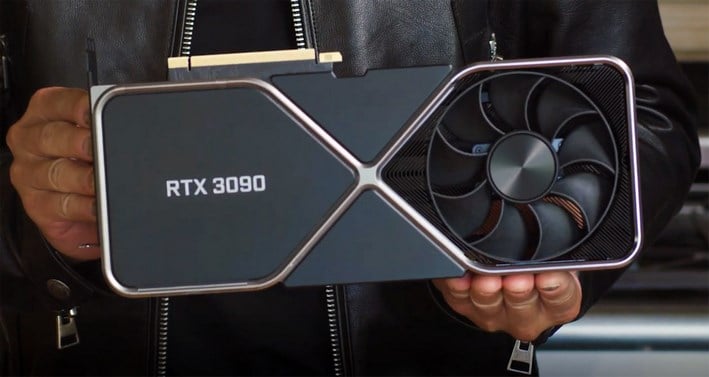
NVIDIA CEO, Jensen Huang, just finished hosting a special GeForce webcast that was chock-full of major announcements. Of course, the star of the show was NVIDIA’s brand-new, oft-leaked Ampere-based GeForce RTX 30 series – which will be available soon -- but a number of additional technologies for gamers and creators were revealed as well, including RTX IO, NVIDIA Reflex, NVIDIA Broadcast, and NVIDIA Omnibus Machina. Needless to say, there’s a lot to cover here; let’s start with the hardware, because we know many of you are eager to see some official GeForce RTX 30 series info, directly from Team Green...
NVIDIA Ampere And The GeForce RTX 30 Series – 2X Faster Than Turing
The initial lineup of Ampere-based GPUs for consumers will consist of three cards: the GeForce RTX 3070, the GeForce RTX 3080, and the GeForce RTX 3090. Jensen is calling the RTX 3080 NVIDIA’s “new flagship”, which may seem confusing to some of you; so let’s explain the new branding.Think of the new GeForce RTX 3080 as the successor to the current GeForce RTX 2080 Ti. The RTX 3080 will reside at the top of NVIDIA’s enthusiast GPU stack, targeting gamers. The GeForce RTX 3070 obviously sits just behind the 3080, while the GeForce RTX 3090 is akin to a GeForce RTX Titan. NVIDIA was somewhat surprised by the demand for its Titan-class graphics cards (not only by gamers, but also by creators and academia as well), so the company decided to go wider with its latest ultra-powerful GPU. Unlike previous GeForce RTX Titans, which were NVIDIA exclusives, moving forward partners will be offering GeForce RTX 3090 series cards as well.
According to Jensen, GeForce RTX 30 series cards based on Ampere offer up to double the performance and 1.9x the power efficiency versus Turing-based GeForce RTX cards. The top-end Ampere GPU is packing a 28 billion transistors and is manufactured on a custom, Samsung 8nm process (8N). However, NVIDIA has optimized many other aspects of the RTX 30-series as well, from the packaging, to the PCB design, and the cooling.
According to the presentation, the new shader cores in Ampere can perform 2 shader ops per clock, versus 1 op on Turing, and concurrent RT + graphic or RT + compute. The 2nd Generation RT cores in the GeForce RTX 3080 offer shader performance of up to 30 TFLOPS (vs. 11 on Turing), RT-TFLOPS of up to 58 (versus 34 RT-TFLOPS in Turing), and the Tensor cores offer up to 238 TFLOPS, versus 89. The more powerful GeForce RTX 3090 ups those numbers to 36 Shader-TFLOPS, 69 RT-TFLOPS, and 285 Tensor-TFLOPS.
The top-end Ampere-based GeForce RTX 30 series cards will also feature Micron’s GDDR6X memory (the 3070 uses standard DDR6), which offers significantly higher bandwidth. GDDR6X uses new 4-level PAM4 signaling with can transmit twice as much data per clock, effectively doubling bandwidth. High-end Ampere-based GeForces will used GDDR6X memory at up to 19Gbps and offer up to 760GB/s of bandwidth.
The coolers on the GeForce RTX 30 series feature a radical new design, with dual axial fans, and a split heatsink design that is reportedly 3x quieter that current solutions, while offering the ability to dissipate up to 90 more watts of power. The front-end of the heatsink sits directly atop the GPU and memory. A fan above directs air through the heatsink and out of the chassis. The heatsink on the back half of the card, however, allows air from the second fan to pass all the way through, where it is rises to the top of the chassis and is eventually exhausted. The end result is lower temperatures and quieter operation.
The more capable coolers on the RTX 30 series accompanies denser PCB designs, with a miniaturized 12-pin power connector on some cards as well – see here for more details. In addition to the unique V-shaped rear edges on the PCBs, they are also packed tighter and are reportedly 50% denser.
In terms of their speeds and feeds, the GeForce RTX 3070, RTX 3080, and RTX 3090 appear to be beasts. The ultra-high-end GeForce RTX 3090 is packing 10,496 CUDA cores, with 24GB of GDDR6 memory. It’s packing a three-slot, dual-axial, flow-through cooler design that NVIDIA claims is up to 10x quieter than the current TITAN RTX, while keeping the GPU up to 30C cooler. And at 4K, the RTX 3090 is up to 50 percent faster than the current TITAN RTX.
The GeForce RTX 3080 has 8,704 CUDA cores, with 10GB of GDDR6X. And the RTX 3070 has 5,888 CUDA cores and 8GB of standard GDDR6. NVIDIA is claiming the GeForce RTX 3080 will offer double the performance of the GeForce RTX 2080. Jensen also said the RTX 3070 is faster than the 2080 Ti as well, though we suspect that’s only with RTX-enabled workloads. Obviously, the beefier GeForce RTX 3090, which Jensen dubbed the “BFGPU”, or Big Ferocious GPU, will be the fastest of all.
Pricing for the GeForce RTX 3070, RTX 3080, and RTX 3090 comes in at $499, $699, and $1,499, respectively. Considering how well Turing has sold, at these price points, we suspect the Ampere-based RTX 30 series is going to sell extremely well, should NVIDIA’s performance claims hold up in independent testing. We sure many of you would be chomping at the bit for a $700 GPU that's twice as fast as a 2080 Ti.
New NVIDIA Features And Technologies For Creators
An interesting feature coming with the GeForce RTX 30 series is called RTX IO. If you’ve been following the upcoming Xbox Series X and PS5 console releases, you’re probably be aware that both platforms incorporate new IO technology to streamline and optimize transfers from solid state storage. RTX IO brings something similar to the PC.With the latest PCIe Gen 4 SSDs capable of ~7GB/s transfers, pulling data from the drives and compressing/decompressing it can require a significant amount of CPU horsepower. RTX IO can minimize CPU overhead when processing data from a fast SSD, and reduce workloads that used to require multiple cores down to a single core, freeing up CPU resources for other operations. RTX IO interfaces with the upcoming DirectStorage API coming to DirectX.
To leverage RTX IO and DirectStorage, games will have to be designed to support the feature, but considering similar technology is coming to both next-gen consoles and the PC, it’s a safe bet game developers will be jumping all over this one.
The company also announced NVIDIA Reflex. NVIDIA Reflex is latency reduction technology that’s designed to optimize end-to-end latency, often referred to as input lag or input latency. NVIDIA Reflex streamlines multiple steps along the rendering pipeline to more efficiently make use of CPU and GPU resources, minimize driver overhead, and according to NVIDIA, reduce latency by up to 50%. That means a gamer’s input – like clicking a mouse button to fire a weapon, for example – causes an in-game response to happen faster. NVIDIA Reflex Low-Latency Mode is currently being integrated into some esports games, like Apex Legends, Call of Duty: Warzone, Fortnite and Valorant, but others will likely be coming.
To help measure latency, NVIDIA will also be introducing the Reflex Latency Analyzer with some upcoming displays. The NVIDIA Reflex Latency Analyzer measures the time it takes for something to change on-screen, as a result of user’s input. The NVIDIA Reflex Latency Analyzer will be integrated into a handful of new 360Hz NVIDIA G-SYNC-enabled displays coming later this fall from companies like Acer, Alienware, ASUS and MSI. Peripheral makers like ASUS, Logitech, SteelSeries and Razer are slated to support the technology as well.
NVIDIA Broadcast is coming to RTX GPUs as well. NVIDIA Broadcast is a plug-in that leverages the GPU and AI to enhance audio and video quality, and offer things like noise reduction, camera tracking and virtual backgrounds. NVIDIA Broadcast should be available to download soon and is compatible with any RTX-enabled GPU, both Turing and Ampere.
NVIDIA also announced something called Omniverse Machinima. When used with compatible games and game engines, NVIDIA Omniverse Machinima is an AI-assisted mixer app that allows users to create physically-accurate animations and characters, using their webcams and assets from the game. The beta should be arriving sometime in October.
We should also note that the GeForce RTX 30 series offers hardware accelerated AV1 decode support, along with HDMI 2.1 as well. Some team members are particularly interested in the HDMI 2.1 support because it will enable 4K120P with G-Sync on some of the latest OLED TVs.
The RTX 30 Series Rips Through Some Impressive Demos
It wouldn’t be a GeForce announcement without an array of graphics and gaming demos to showcase the capabilities and features of the new GPUs. During the broadcast, Jensen showed off a number of upcoming games and specialized demos that spotlighted many of Ampere’s new features and capabilities.One demo showed a scaled-up image using DLSS 2.0 offering sharper edges and additional details versus a native 4K render, but as our testing as shown, despite its strengths and ability to improve performance with RTX-On, it doesn’t universally offer better (or increased) image quality relative to native rendering.
Another demo showed the highly-anticipated Cyberpunk 2077 running with ray-traced reflections, diffused illumination, and DLSS 2.0, along with some new footage from Call Of Duty: Black Ops – Cold War using RTX features was shown as well. It was also announced the Fortnite was getting RTX support. One of the more impressive demos, however, was NVIDIA’s own Marbles RTX demo, which has been enhanced for Ampere.
Marbles RTX is a dynamic, fully ray traced world, with path traced lighting, and highly complex physics and models. At GTC 2020, NVIDIA showed the original Marbles RTX running on a single Quadro RTX 8000 with DLSS, Dynamic Super Resolution and AI Denoising at 720p at about 25 FPS. A single GeForce RTX 3090, however, running the enhanced Marbles RTX demo, with added depth of field and additional lighting, is able to hit approximately 30 FPS at a 1440p resolution, which equated to about 4X the performance.
Finally, Jensen also showed some video of a handful of creators that were invited to NVIDIA HQ to experience the GeForce RTX 3090 gaming on an 8K LG OLED TV at 60 FPS.
When Can You Buy A GeForce RTX 30 Series GPU?
NVIDIA’s GeForce RTX 30 series is in full production now. The GeForce RTX 3080 is slated to arrive on September 17th. The high-end GeForce RTX 3090 will arrive about a week after on September 24 and the GeForce RTX 3070 will land sometime in October.We are hoping to have full reviews of NVIDIA’s new cards as they are made available. Considering pricing and expected performance, the GeForce RTX 30 series is definitely going to shake up the GPU market. Turing-based RTX cards may see a significant price drop as resellers unload existing inventory, if the GeForce RTX 3070 and RTX 3080 blow past the current RTX 2080 Ti across the board, as today’s news suggests. And AMD, which is slated to announce its next-generation RDNA2-based GPUs soon, now has an official target. Whether or not they’re able to come close to Ampere and the GeForce RTX 30 series remains to be seen, but one thing is certain – the holiday shopping season is going to flush with new technology, between Ampere, RDNA2, Tiger Lake, the next-gen consoles and whatever else may be announced in the coming weeks.

